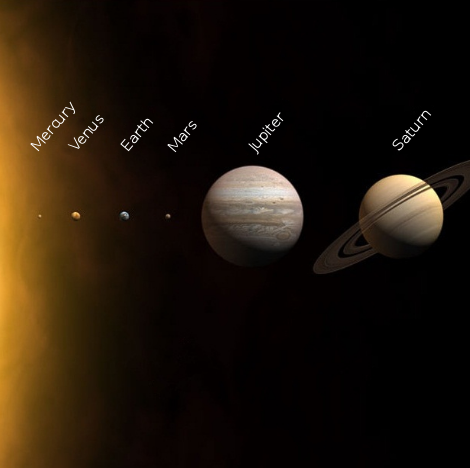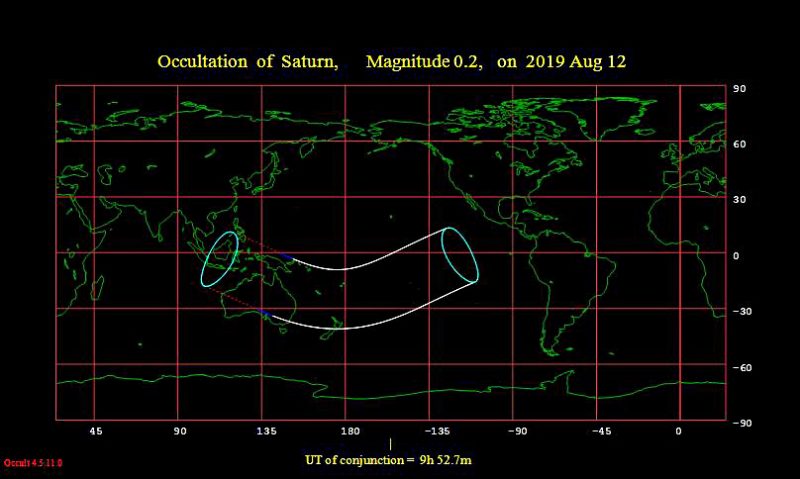On the evenings of August 9, 10 and 11, 2019, people will be looking outside at the planets near the waxing gibbous moon and wondering about their meteor-watching chances for that night. After all, the peak of the annual Perseid meteor shower is likely the morning of August 13, and the Perseids are known to rise gradually to a peak. The days leading up to this shower’s peak are often quite good for meteor-watching. But that moon! It’ll definitely be in the way for much of the night, beginning August 9 and through the peak nights. The planets Jupiter and Saturn – near the moon on these nights – are consolation prizes at best.
The moon will set in the wee hours before dawn (although later and later each morning). If you want to watch meteors, try in the mornings before the peak, when there will be a very small window indeed between moonset and dawn.
Read more: All you need to know about Perseid meteors in 2019
And in the meantime, on these nights leading up to the Perseids’ peak, let the moon guide you to the gas giants Jupiter and Saturn. Despite the lunar glare, you should have no trouble seeing them. Jupiter ranks as the fourth-brightest celestial object to light up the sky, after the sun, moon and planet Venus. Right now, Venus is lost in the sun’s glare, and it’ll be gone throughout August 2019. There’s no way to mistake Venus for Jupiter this month. Saturn is fainter, but still as bright as the sky’s brightest stars. You’ll see Saturn, too, if your sky is clear.
The moon, Jupiter and Saturn – plus the nearby bright star Antares – pop out at nightfall. Afterwards, all these heavenly bodies will travel westward throughout the night. They travel westward for the same reason that the sun travels westward during the day. The Earth spins from west-to-east on its rotational axis, making it appear as if the sun, moon, planets and stars travel full circle westward around Earth each day while the Earth stays still. It’s really our spinning Earth that’s doing the moving.

Meanwhile, the moon in its orbit is always moving eastward in front of the constellations of the zodiac. Because Saturn lodges to the east of Jupiter on the sky’s dome, the moon is moving toward Saturn on August 9, 10 and 11, 2019. Relative to the stars of the zodiac, the moon moves about 1/2 degree (its own angular diameter) eastward per hour or about 13 degrees eastward per day. After just one day, the moon’s change of position relative to the planets Jupiter and Saturn, plus the star Antares, will be obvious.
On August 11 or 12, depending on where you live worldwide, the moon will pass to the north of Saturn, right over Saturn, or to the south of Saturn. We refer you to the worldwide map below via IOTA (International Occultation Timing Association). Given clear skies, the swath of the world in between the white lines can watch the moon occult (cover over) Saturn in a nighttime sky.

We give the local times for the occultation for two localities:
Sydney, Australia (August 12, 2019)
Occultation begins (Saturn disappears): 6:34 p.m. local time
Occultation ends (Saturn reappears): 7:23 p.m. local timeAuckland, New Zealand (August 12, 2019)
Occultation begins (Saturn disappears): 9:16 p.m. local time
Occultation ends (Saturn reappears): 10:15 p.m. local time
Click here for the occultation times for numerous localities but remember to convert Universal Time to local time. Here’s how.
After the moon has moved out of the evening sky in the second half of August 2019, use Jupiter and Saturn to find the Teapot asterism (a prominent star pattern) in the constellation Sagittarius the Archer. This is the direction of the center of our Milky Way galaxy. In a dark sky, you might imagine “steam” (really, countless distant stars) billowing out of the Teapot’s spout, arching across the dome of the sky. This steam is actually the combined glow of myriads of far-off suns in the direction of the galaxy’s center.

Read more: The Teapot, and the galaxy’s center

Bottom line: The Perseid meteor shower is rising to its peak, so there’s bound to be some fist-shaking on the weekend of August 9, 10 and 11, 2019, at that bright moon. But the moon can also guide you to Jupiter and Saturn on these nights. Later, after the moon has moved away, you can use these two planets to locate the famous Teapot asterism in the constellation Sagittarius, which points the way to the center of our Milky Way galaxy.











